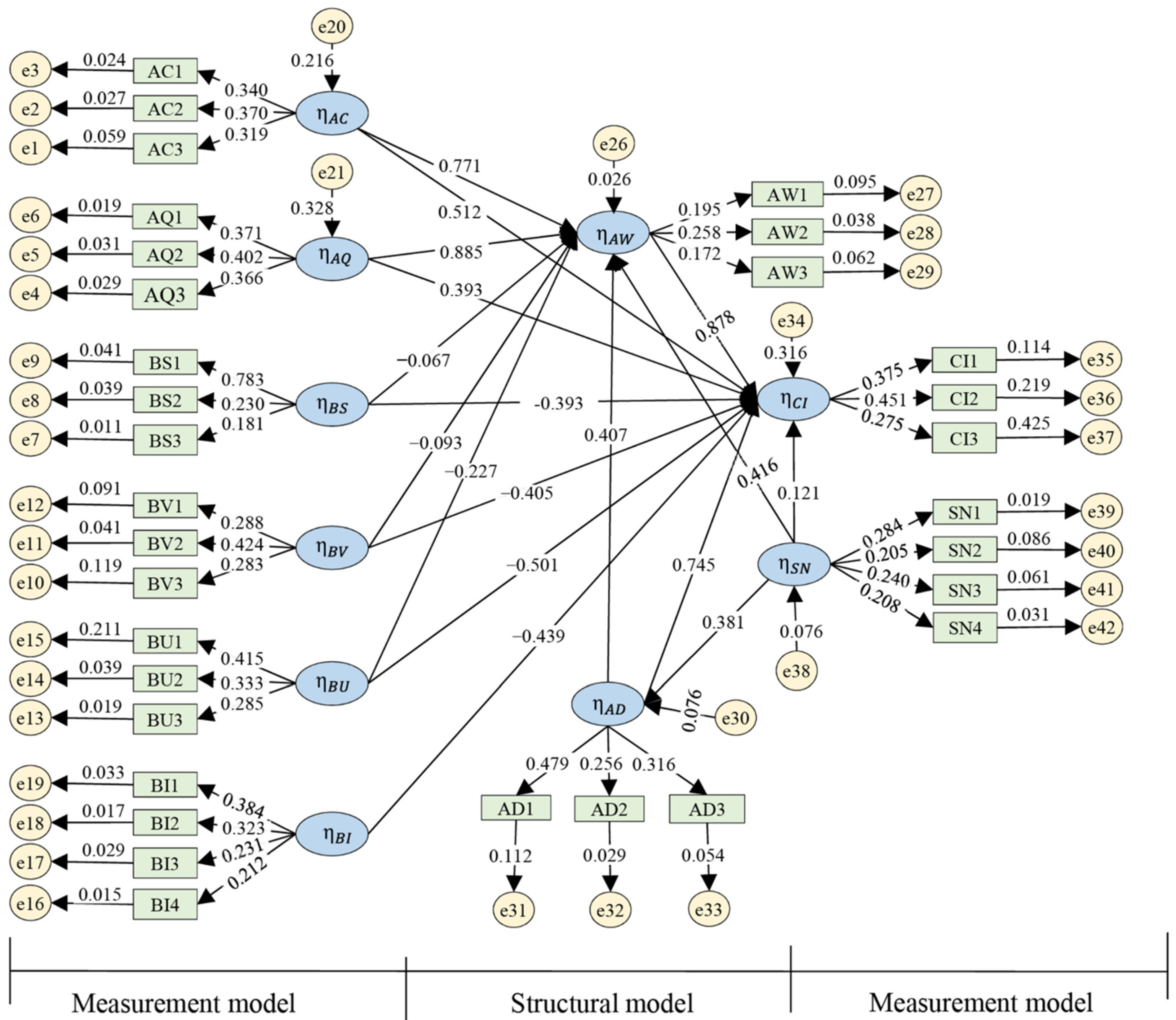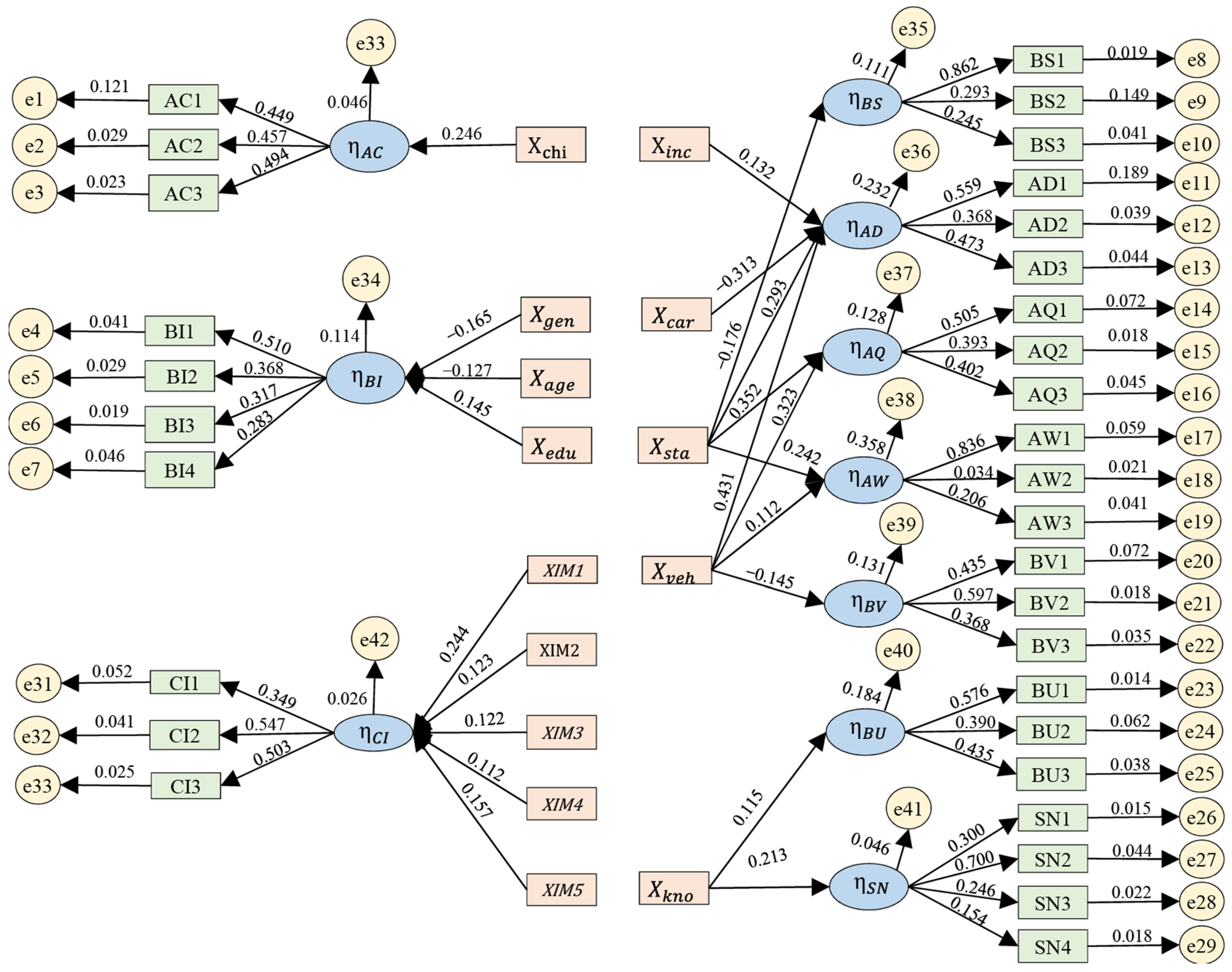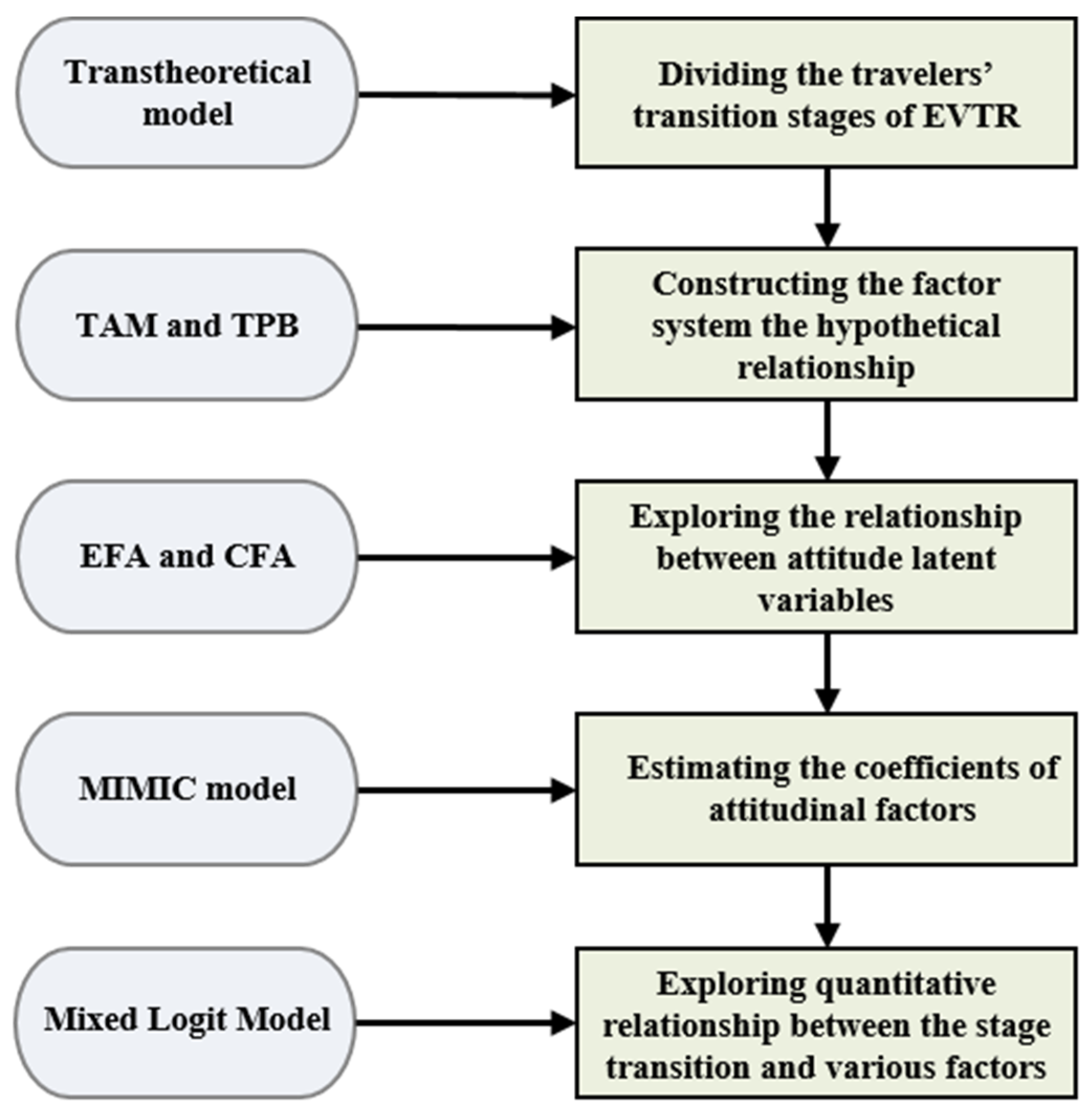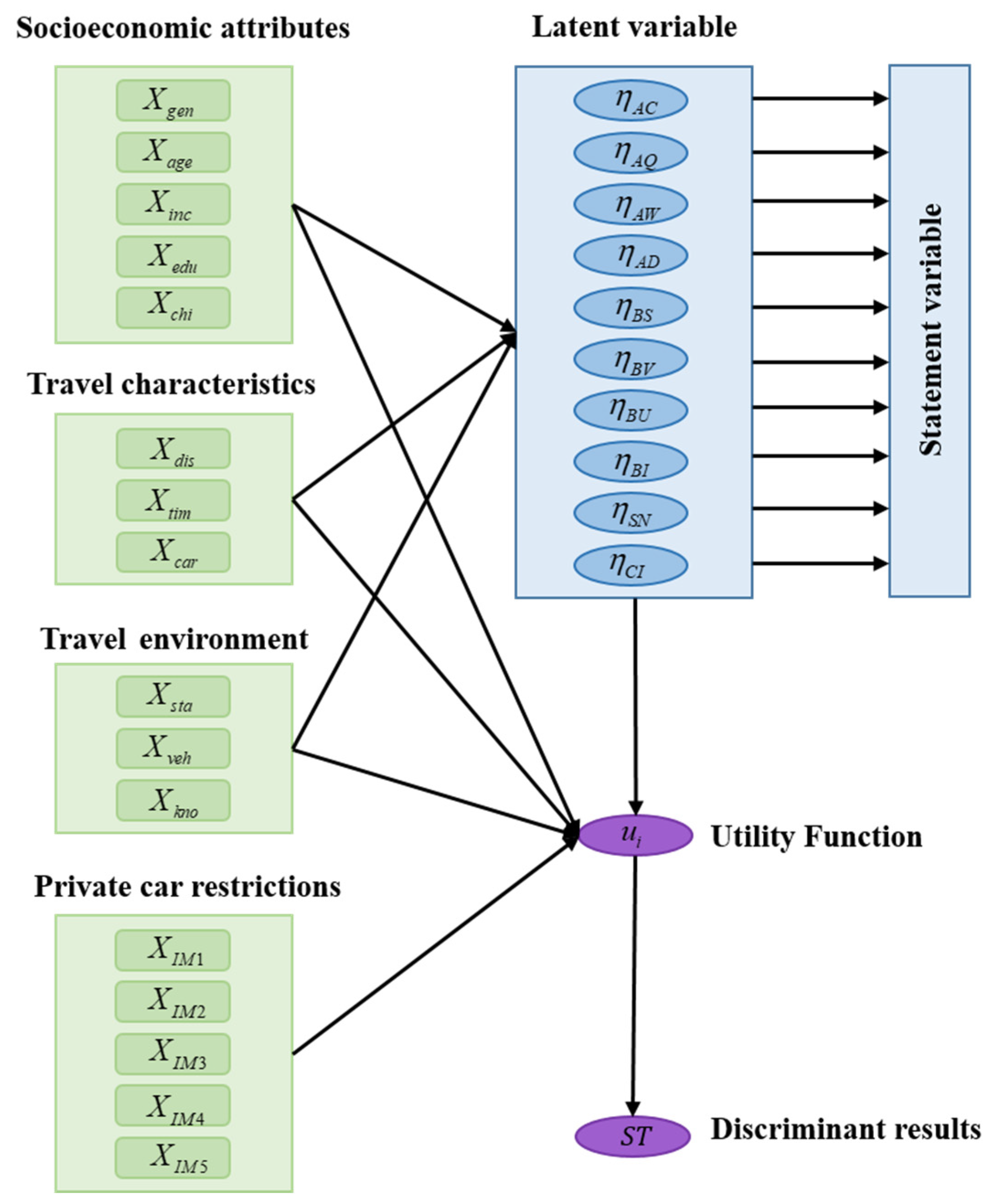Exploring the Role of Attitudinal Factors in Electric Vehicle Timeshare Rentals Adoption
Abstract
1. Introduction
2. Methodology
2.1. Overall Framework
2.2. Factor System Construction
- TAM: TAM is mainly used to analyze people’s acceptance of new technologies and products and their influencing factors. The theory holds that people’s use willingness determines adoption and use frequency, which is determined by people’s attitudes towards technology or system and perceived usefulness, while people’s attitudes are influenced by perceived usefulness and perceived ease of use;
- TPB: TPB is a theory explaining the relationship between attitude and behavior in social psychology. It holds that when an individual takes a positive attitude towards a particular behavior, thinks that it conforms to their subjective behavioral norms, and feels that they have mastered the skills and resources to adopt the behavior, they will have strong use willingness, and the probability of actual behavior will increase significantly.
| Latent Variable | Index | Description |
|---|---|---|
| Perceived comfort | The respondents’ attitude towards the comfort of EVTRs | |
| Perceived efficiency | The respondents’ attitude toward the efficiency of EVTRs | |
| Subjective evaluation | Investigators’ overall understanding and evaluation of EVTRs | |
| Use preference | The direct preference of respondents to travel using EVTRs | |
| Station inconvenience | Investigator perceived barriers to EVTR station | |
| Station inconvenience | Investigator perceived barriers to EVTR vehicle | |
| Use inconvenience | Investigator perceived barriers to the use of EVTRs | |
| Personal inconvenience | Investigators’ personal barriers to using EVTRs | |
| Social pressure | Social pressure sensed by investigators when using EVTRs | |
| Use willingness | Investigators’ willingness and possibility to use EVTRs |
2.3. MIMIC Model
2.4. Mixed Logit Model
3. Data
4. Results
4.1. Estimating Correlations between Variables Using MIMIC
4.1.1. The Correlation between Attitude Latent Variables
- The coefficient between use preference and use willingness in the MIMIC model is 0.745, indicating that use preference is positively related to use willingness, which proves that Hypothesis 1 is true;
- The coefficient between perceived usefulness and use willingness in the MIMIC model is positive (perceived comfort 0.512 and perceived efficiency 0.593), indicating that perceived usefulness is positively related to use willingness, which proves that Hypothesis 2 is true;
- The coefficient between travel obstacles and use willingness in the MIMIC model is negative (station inconvenience −0.393, station inconvenience −0.405, use inconvenience −0.501, and personal inconvenience −0.439), indicating that perceived availability is positively related to use willingness, which proves that Hypothesis 3 is true;
- The coefficient between subject norm and use willingness in the MIMIC model is 0.121, indicating that subject norm is positively related to use willingness, which proves that Hypothesis 4 is true;
- The coefficient between subjective evaluation and use willingness in the MIMIC model is 0.878, indicating that subjective evaluation is positively related to use willingness, which proves that Hypothesis 5 is true.

- The coefficient of indirect effect between perceived comfort and use willingness is 0.078, indicating that perceived comfort has a positive impact on use willingness through subjective evaluation, which proves that Hypothesis 6 is true;
- The coefficient of indirect effect between perceived efficiency and use willingness is 0.203, indicating that perceived efficiency has a positive impact on use willingness through subjective evaluation, which proves that Hypothesis 7 is true;
- The coefficient of indirect effect between social pressure and use willingness is 0.127, indicating that social pressure positively impacts use willingness through subjective evaluation, which proves that Hypothesis 8 is true;
- The coefficient of indirect effect between use preference and use willingness is 0.116, indicating that use preference positively impacts use willingness through subjective evaluation, which proves that Hypothesis 8 is true.
4.1.2. The Correlation between Latent Attitude Variables and Exogenous Variables
4.1.3. The Correlation between Latent Attitude Variables and Statement Variables

| −0.165 (2.122) | ||||||||||
| −0.127 (5.715) | ||||||||||
| 0.132 (3.072) | ||||||||||
| 0.145 (4.323) | ||||||||||
| 0.246 (2.721) | ||||||||||
| −0.313 (8.072) | ||||||||||
| 0.352 (4.602) | 0.242 (6.045) | 0.293 (2.883) | −0.176 (11.773) | |||||||
| 0.323 (6.101) | 0.112 (2.262) | 0.431 (12.292) | −0.145 (3.812) | |||||||
| −0.115 (5.429) | 0.213 (3.624) | |||||||||
| 0.244 (2.722) | ||||||||||
| 0.123 (4.116) | ||||||||||
| 0.122 (3.982) | ||||||||||
| 0.112 (5.752) | ||||||||||
| 0.157 (2.385) |
| Latent Factor | Statement Variable | Estimate | S.E. | C.R. | P |
|---|---|---|---|---|---|
| AC1 | 1 | ||||
| AC2 | 1.017 | 0.140 | 9.597 | 0.009 | |
| AC3 | 2.102 | 0.275 | 6.642 | 0.032 | |
| AQ1 | 1 | ||||
| AQ2 | 0.778 | 0.109 | 10.767 | 0.006 | |
| AQ3 | 0.796 | 0.096 | 7.765 | 0.006 | |
| AW1 | 1 | ||||
| AW2 | 0.246 | 0.029 | 5.978 | 0.021 | |
| AW3 | 0.428 | 0.045 | 9.005 | 0.012 | |
| AD1 | 1 | ||||
| AD2 | 0.658 | 0.084 | 5.610 | 0.009 | |
| AD3 | 0.847 | 0.091 | 4.668 | 0.008 | |
| BS1 | 1 | ||||
| BS2 | 0.340 | 0.041 | 10.433 | 0.031 | |
| BS3 | 0.284 | 0.042 | 6.422 | 0.155 | |
| BV1 | 1 | ||||
| BV2 | 0.677 | 0.079 | 2.946 | 0.033 | |
| BV3 | 0.755 | 0.108 | 4.927 | 0.041 | |
| BU1 | 1 | ||||
| BU2 | 4.373 | 0.468 | 5.888 | 0.038 | |
| BU3 | 0.845 | 0.109 | 7.339 | 0.019 | |
| BI1 | 1 | ||||
| BI2 | 0.722 | 0.086 | 8.173 | 0.030 | |
| BI3 | 0.622 | 0.064 | 5.119 | 0.034 | |
| BI4 | 0.595 | 0.068 | 7.068 | 0.039 | |
| SN1 | 1 | ||||
| SN2 | 0.429 | 0.053 | 10.156 | 0.045 | |
| SN3 | 0.351 | 0.046 | 3.151 | 0.032 | |
| SN4 | 0.220 | 0.027 | 6.027 | 0.012 | |
| CI1 | 1 | ||||
| CI2 | 1.566 | 0.230 | 8.830 | 0.005 | |
| CI3 | 1.441 | 0.209 | 7.877 | 0.004 |
4.2. EVTR Travel Choice Prediction Using Two Mixed Logit Models
4.2.1. EVTR Travel Selection Model without Latent Variables
| Variable | B | S.E. | Sig. | Exp (B) |
|---|---|---|---|---|
| Constant | −1.600 | 1.052 | 0.013 | 0.202 |
| 0.052 | 0.180 | 0.038 | 1.053 | |
| −0.019 | 0.087 | 0.043 | 0.981 | |
| 0.029 | 0.100 | 0.027 | 1.029 | |
| 0.081 | 0.110 | 0.046 | 1.084 | |
| 0.154 | 0.199 | 0.064 | 1.166 | |
| −0.486 | 0.186 | 0.030 | 0.615 | |
| −0.121 | 0.103 | 0.023 | 0.886 | |
| 0.012 | 0.081 | 0.028 | 1.012 | |
| 0.314 | 0.084 | 0.018 | 1.369 | |
| 0.090 | 0.110 | 0.041 | 1.094 | |
| 0.075 | 0.110 | 0.044 | 1.078 | |
| 0.169 | 0.109 | 0.012 | 1.184 | |
| 0.082 | 0.111 | 0.046 | 1.085 | |
| 0.152 | 0.140 | 0.017 | 1.164 | |
| n | 619 | |||
| Log likelihood | 742.995 | |||
| McFadden’s R2 | 0.273 | |||
4.2.2. EVTR Travel Selection Model with Latent Variables
5. Conclusions
Author Contributions
Funding
Institutional Review Board Statement
Informed Consent Statement
Data Availability Statement
Conflicts of Interest
References
- Long, Y.; Zhang, Y.; Sun, H.; Hou, X.; Xiao, J. A Developed Vehicle Terminal of Time-Sharing Rental Electric Vehicle Using Acoustic Communication Technology. Appl. Sci. 2019, 9, 5408. [Google Scholar] [CrossRef]
- Kajanova, M.; Bracinik, P. The Vehicle-to-Grid Concept with Respect to the Preferences of Electric Vehicle Drivers and Charging Station Operators. Appl. Sci. 2022, 12, 5476. [Google Scholar] [CrossRef]
- Alfian, G.; Rhee, J.; Ijaz, M.F.; Syafrudin, M.; Fitriyani, N.L. Performance Analysis of a Forecasting Relocation Model for One-Way Carsharing. Appl. Sci. 2017, 7, 598. [Google Scholar] [CrossRef]
- Yang, J.; Lin, Y.; Wu, F.; Chen, L. Subsidy and Pricing Model of Electric Vehicle Sharing Based on Two-Stage Stackelberg Game—A Case Study in China. Appl. Sci. 2019, 9, 1631. [Google Scholar] [CrossRef]
- Turoń, K.; Kubik, A. Economic Aspects of Driving Various Types of Vehicles in Intelligent Urban Transport Systems, Including Car-Sharing Services and Autonomous Vehicles. Appl. Sci. 2020, 10, 5580. [Google Scholar] [CrossRef]
- Changaival, B.; Lavangnananda, K.; Danoy, G.; Kliazovich, D.; Guinand, F.; Brust, M.; Musial, J.; Bouvry, P. Optimization of Carsharing Fleet Placement in Round-Trip Carsharing Service. Appl. Sci. 2021, 11, 11393. [Google Scholar] [CrossRef]
- Sun, L.; Wang, S.; Liu, S.; Yao, L.; Luo, W.; Shukla, A. A completive research on the feasibility and adaptation of shared transportation in mega-cities—A case study in Beijing. Appl. Energy 2018, 230, 1014–1033. [Google Scholar] [CrossRef]
- Galatoulas, N.-F.; Genikomsakis, K.N.; Ioakimidis, C.S. Analysis of potential demand and costs for the business development of an electric vehicle sharing service. Sustain. Cities Soc. 2018, 42, 148–161. [Google Scholar] [CrossRef]
- Bobeth, S.; Kastner, I. Buying an electric car: A rational choice or a norm-directed behavior? Transp. Res. Part F Traffic Psychol. Behav. 2016, 73, 236–258. [Google Scholar] [CrossRef]
- Autolib. Autolib Service Shut Down. Available online: https://www.autolib.eu (accessed on 1 July 2018).
- SOHU. Is Autolib Going to the End? Available online: www.sohu.com/a/234831160_236796 (accessed on 9 June 2018).
- Aurora Big Data. Research Report on Carsharing in January 2019. Available online: http://www.199it.com/archives/828369 (accessed on 1 July 2018).
- Taru, J.; Marilyn, J.; Geoffrey, R. Exploring the process of travel behaviour change and mobility trajectories associated with car share adoption. Travel Behav. Soc. 2020, 18, 117–131. [Google Scholar]
- Efthymiou, D.; Antoniou, C.; Waddell, P. Factors affecting the adoption of vehicle sharing systems by young drivers. Transp. Policy 2013, 29, 64–73. [Google Scholar] [CrossRef]
- Millard-Ball, A.; Murray, G.; TerSchure, J.; Fox, C.; Burkhardt, J. Car-Sharing: Where and How It Succeeds. Transit Cooperative Research Program (TCRP) Report 108; Transportation Research Board: Washington, DC, USA, 2005. [Google Scholar]
- Shaheen, S. Dynamics in Behavioral Adaptation to a Transportation Innovation: A Case Study of Carlink—A Smart Carsharing System. Ph.D. Thesis, Institute of Transportation Studies, University of California, Davis, CA, USA, 2004. [Google Scholar]
- Arena, M.; Azzone, G.; Colorni, A.; Conte, A.; Luè, A.; Nocerino, R. Service design in electric vehicle sharing: Evidence from Italy. IET Intell. Transp. Syst. 2015, 9, 145–155. [Google Scholar] [CrossRef]
- Boyacı, B.; Zografos, K.G.; Geroliminis, N. An optimization framework for the development of efficient one-way car-sharing systems. Eur. J. Oper. Res. 2015, 240, 718–733. [Google Scholar] [CrossRef]
- Luè, A.; Colorni, A.; Nocerino, R.; Paruscio, V. Green Move: An Innovative Electric Vehicle-Sharing System. Procedia—Soc. Behav. Sci. 2012, 48, 2978–2987. [Google Scholar] [CrossRef]
- Biondi, E.; Boldrini, C.; Bruno, R. Optimal charging of electric vehicle fleets for a carsharing system with power sharing. In Proceedings of the 2016 IEEE International Energy Conference (ENERGYCON), Leuven, Belgium, 4–8 April 2016. [Google Scholar]
- Wang, H.; Li, Z.; Zhu, X.; Liu, Z. A Full Service Model for Vehicle Scheduling in One-Way Electric Vehicle Car-Sharing Systems. In International Conference on Internet of Vehicles; Springer: Cham, Switzerland, 2015; pp. 25–36. [Google Scholar] [CrossRef]
- Wang, N.; Yan, R. Research on Consumers’ Use Willingness and Opinions of Electric Vehicle Sharing: An Empirical Study in Shanghai. Sustainability 2015, 8, 7. [Google Scholar] [CrossRef]
- Heilig, M.; Mallig, N.; Schröder, O.; Kagerbauer, M.; Vortisch, P. Implementation of free-floating and station-based carsharing in an agent-based travel demand model. Travel Behav. Soc. 2017, 12, 151–158. [Google Scholar] [CrossRef]
- Habib, K.M.N.; Morency, C.; Islam, M.T.; Grasset, V. Modelling users’ behaviour of a carsharing program: Application of a joint hazard and zero inflated dynamic ordered probability model. Transp. Res. Part A Policy Pract. 2012, 46, 241–254. [Google Scholar] [CrossRef]
- Paundra, J.; Rook, L.; van Dalen, J.; Ketter, W. Preferences for carsharing services: Effects of instrumental attributes and psychological ownership. J. Environ. Psychol. 2017, 53, 121–130. [Google Scholar] [CrossRef]
- Mishra, G.S. Estimating the Travel Behaviour Effects of Technological Innovations from Cross Sectional Observed Data: Applications to Carsharing and Telecommuting; University of California: Davis, CA, USA, 2017. [Google Scholar]
- Wu, C.; Le Vine, S.; Sivakumar, A.; Polak, J. Traveller preferences for free-floating carsharing vehicle allocation mechanisms. Transp. Res. Part C Emerg. Technol. 2019, 102, 1–19. [Google Scholar] [CrossRef]
- Li, Z.; Wang, W.; Yang, C.; Ragland, D.R. Bicycle commuting market analysis using attitudinal market segmentation approach. Transp. Res. Part A Policy Pract. 2013, 47, 56–68. [Google Scholar] [CrossRef]
- Xiong, Q.; Zhang, Q.; Yang, Y.; Li, Z. Perceived barriers faced by Chinese adult children in social support of their elderly parents’ outbound travels. Tour. Manag. Perspect. 2021, 38, 100827. [Google Scholar] [CrossRef]
- Golob, T.F.; Hensher, D.A. Greenhouse gas emissions and australian commuters’ attitudes and behavior concerning abatement policies and personal involvement. Transp. Res. Part D Transp. Environ. 1998, 3, 1–18. [Google Scholar] [CrossRef]
- Gärling, T.; Fujii, S.; Boe, O. Empirical tests of a model of determinants of script-based driving choice. Transp. Research. Part F Traffic Psychol. Behav. 2001, 4, 89–102. [Google Scholar] [CrossRef]
- Golob, T.F. Structural equation modeling for travel behavior research. Transp. Res. Part B (Methodol.) 2003, 37, 1–25. [Google Scholar] [CrossRef]
- Outwater, M.L.; Castleberry, S.; Shiftan, Y.; Ben-Akiva, M.; Zhou, Y.S.; Kuppam, A. Attitudinal market segmentation approach to mode choice and ridership forecasting—Structural equation modeling. Transp. Res. Rec. 1854, 2003, 32–42. [Google Scholar] [CrossRef]
- Shiftan, Y.; Outwater, M.L.; Zhou, Y. Transit market research using structural equation modeling and attitudinal market segmentation. Transp. Policy 2008, 15, 186–195. [Google Scholar] [CrossRef]
- Bert, J.; Collie, B.; Gerrits, M.; Xu, G. What’s Ahead for Car Sharing?: The New Mobility and Its Impact on Vehicle Sales. 2016. Available online: https://www.bcg.com/publications/2016/automotive-whats-ahead-car-sharing-new-mobility-its-impact-vehicle-sales (accessed on 23 February 2016).
- Esfandabadi, Z.S.; Diana, M.; Zanetti, M.C. Carsharing services in sustainable urban transport: An inclusive science map of the field. J. Clean. Prod. 2022, 357, 131981. [Google Scholar] [CrossRef]
- Chen, C.F.; Chao, W.H. Habitual or reasoned? Using the theory of planned behavior, technology acceptance model, and habit to examine switching intentions toward public transit. Transp. Res. Part F Traffic Psychol. Behav. 2011, 14, 128–137. [Google Scholar] [CrossRef]
- Anable, J. ‘Complacent car addicts’ or ‘aspiring environmentalists’? Identifying travel behaviour segments using attitude theory. Transp. Policy 2005, 12, 65–78. [Google Scholar] [CrossRef]
- Dill, J.; Voros, K. Factors Affecting Bicycling Demand: Initial Survey Findings from the Portland, Oregon, Region. Transp. Res. Rec. J. Transp. Res. Board 2007, 2031, 9–17. [Google Scholar] [CrossRef]
- Marsh, H.W.; Muthén, B.; Asparouhov, T.; Lüdtke, O.; Robitzsch, A.; Morin, A.J.; Trautwein, U. Exploratory structural equation modeling, integrating CFA and EFA: Application to students’ evaluations of university teaching. Struct. Equ. Model. Multidiscip. J. 2009, 16, 439–476. [Google Scholar] [CrossRef]
- Wen, Z.; Marsh, H.W.; Hau, K.T. Structural Equation Models of Latent Interactions: An Appropriate Standardized Solution and Its Scale-Free Properties. Struct. Equ. Model. A Multidiscip. J. 2010, 17, 1–22. [Google Scholar] [CrossRef]
- Wen, Z.; Fan, X. Monotonicity of effect sizes: Questioning kappa-squared as mediation effect size measure. Psychol. Methods 2015, 20, 193–203. [Google Scholar] [CrossRef]
- Nkurunziza, A.; Zuidgeest, M.; Brussel, M.; Van Maarseveen, M. Examining the potential for modal change: Motivators and barriers for bicycle commuting in Dar-es-Salaam. Transp. Policy 2012, 24, 249–259. [Google Scholar] [CrossRef]


| Latent Variables | Observation Variables | Definition | Mean | Std. |
|---|---|---|---|---|
| AC1 | The safety of EVTR is good. | 3.04 | 1.19 | |
| AC2 | The comfort of EVTR is good. | 2.97 | 1.56 | |
| AC3 | Traveling with a shared EVs is easy and convenient. | 2.98 | 1.14 | |
| AQ1 | The accessibility of using EVTR to travel is higher. | 3.07 | 1.63 | |
| AQ2 | The convenience of EVTR is good. | 3.11 | 0.82 | |
| AQ3 | Using EVTR to travel is fast and saves time. | 3.06 | 1.33 | |
| AW1 | EVTR is environmentally friendly. | 3.97 | 1.78 | |
| AW2 | The economic cost of using EVTR to travel is lower. | 3.00 | 1.15 | |
| AW3 | EVTR is conducive to sustainable development. | 3.93 | 1.41 | |
| AD1 | EVTR can satisfy my travel needs. | 3.04 | 1.64 | |
| AD2 | I am satisfied with the travel service of EVTR. | 3.02 | 1.78 | |
| AD3 | EVTR is better than other traffic modes. | 3.03 | 1.13 | |
| BS1 | There are fewer EVTR stations around the origin. | 3.91 | 1.68 | |
| BS2 | There are fewer EVTR stations around the destination. | 3.91 | 0.88 | |
| BS3 | There are fewer shared EVs available at the station. | 3.05 | 0.80 | |
| BU1 | It is inconvenient to deal with EVTR traffic violations. | 3.03 | 0.93 | |
| BU2 | EVTR is too expensive to use. | 3.05 | 1.32 | |
| BU3 | It is inconvenient to rent or return shared vehicles. | 3.13 | 1.29 | |
| BV1 | The endurance mileage of EVs is too small to meet the travel needs. | 3.04 | 0.85 | |
| BV2 | The type of vehicle available for EVTR is too single. | 3.10 | 0.92 | |
| BV3 | The driving performance of shared EVs is poor. | 3.01 | 1.04 | |
| BI1 | I’m not good at driving because of my poor driving skills. | 3.05 | 1.44 | |
| BI2 | My economic conditions cannot afford to use EVTR. | 2.99 | 1.39 | |
| BI3 | My travel environment is not suitable for EVTR. | 3.05 | 1.27 | |
| BI4 | My physical condition is not suitable for driving a car. | 2.83 | 1.18 | |
| CI1 | My friends think that I should use EVTR to travel. | 3.02 | 1.48 | |
| CI2 | My friends often use EVTR to travel. | 3.10 | 0.97 | |
| CI3 | I will use EVTR to travel because my friends use it. | 3.03 | 1.03 | |
| SN1 | Society advocates sharing travel and green travel. | 2.99 | 1.23 | |
| SN2 | I’m willing to use EVTR to travel often. | 2.96 | 1.18 | |
| SN3 | I will encourage friends to use EVTR. | 3.00 | 1.10 | |
| SN4 | I am willing to transition from other traffic modes to EVTR. | 3.81 | 1.40 |
| Socioeconomic Characteristics | Valid Sample (N = 619) | EVS User (N = 188) | Non-EVS User (N = 431) | |||
|---|---|---|---|---|---|---|
| Mean | Std. | Mean | Std. | Mean | Std. | |
| Age (year) | 3.15 | 0.29 | 3.14 | 0.28 | 3.15 | 0.09 |
| Gender (female-1) | 1.47 | 0.09 | 1.47 | 0.14 | 1.47 | 0.11 |
| Education (college or higher = 1) | 3.05 | 0.26 | 3.01 | 0.16 | 3.06 | 0.19 |
| Individual income (1000 USD/year) | 3.33 | 0.21 | 3.35 | 0.29 | 3.32 | 0.21 |
| Marriage (yes = 1) | 0.90 | 0.05 | 0.94 | 0.08 | 0.88 | 0.08 |
| Child (yes = 1) | 0.70 | 0.06 | 0.72 | 0.07 | 0.70 | 0.02 |
| Automobile available (yes = 1) | 0.32 | 0.02 | 0.39 | 0.03 | 0.29 | 0.02 |
| EVTR Station density (low = 1) | 2.33 | 0.18 | 3.80 | 0.25 | 1.69 | 0.12 |
| EVTR fleet size (low = 1) | 2.31 | 0.17 | 3.65 | 0.28 | 1.73 | 0.13 |
| Familiarity with EVTR (low = 1) | 2.72 | 0.24 | 4.02 | 0.31 | 2.16 | 0.15 |
| Dependent | Independent a | Direct Effect | Indirect Effect | Total Effect |
|---|---|---|---|---|
| 0.878 | / b | 0.878 | ||
| 0.745 | 0.078 | 0.823 | ||
| 0.593 | 0.203 | 0.796 | ||
| 0.512 | 0.127 | 0.639 | ||
| −0.501 | / | −0.501 | ||
| −0.439 | / | −0.439 | ||
| −0.405 | / | −0.405 | ||
| −0.393 | / | −0.393 | ||
| 0.121 | 0.116 | 0.278 |
| Variable | B | S.E. | Sig. | Exp (B) |
|---|---|---|---|---|
| Constant | −2.700 | 1.611 | 0.014 | 0.067 |
| −0.023 | 0.184 | 0.090 | 0.977 | |
| −0.032 | 0.089 | 0.072 | 0.969 | |
| 0.018 | 0.102 | 0.186 | 1.018 | |
| −0.076 | 0.112 | 0.060 | 0.927 | |
| 0.096 | 0.205 | 0.064 | 1.101 | |
| 0.499 | 0.19 | 0.009 | 1.647 | |
| −0.079 | 0.103 | 0.043 | 0.924 | |
| −0.033 | 0.083 | 0.039 | 0.968 | |
| −0.144 | 0.086 | 0.020 | 0.866 | |
| 0.057 | 0.133 | 0.006 | 1.059 | |
| 0.057 | 0.122 | 0.016 | 1.059 | |
| 0.136 | 0.112 | 0.022 | 1.146 | |
| −0.097 | 0.114 | 0.040 | 0.908 | |
| 0.117 | 0.114 | 0.030 | 1.124 | |
| 0.387 | 0.181 | 0.032 | 1.473 | |
| 0.211 | 0.173 | 0.037 | 1.235 | |
| 0.165 | 0.163 | 0.031 | 1.179 | |
| 0.174 | 0.151 | 0.025 | 0.840 | |
| −0.005 | 0.137 | 0.027 | 0.995 | |
| −0.121 | 0.174 | 0.049 | 0.886 | |
| −0.277 | 0.187 | 0.014 | 0.758 | |
| −0.263 | 0.179 | 0.014 | 1.301 | |
| 0.162 | 0.178 | 0.086 | 1.176 | |
| 0.023 | 0.184 | 0.040 | 0.977 | |
| n | 619 | |||
| Log likelihood | 727.120 | |||
| McFadden’s R2 | 0.341 | |||
Disclaimer/Publisher’s Note: The statements, opinions and data contained in all publications are solely those of the individual author(s) and contributor(s) and not of MDPI and/or the editor(s). MDPI and/or the editor(s) disclaim responsibility for any injury to people or property resulting from any ideas, methods, instructions or products referred to in the content. |
© 2022 by the authors. Licensee MDPI, Basel, Switzerland. This article is an open access article distributed under the terms and conditions of the Creative Commons Attribution (CC BY) license (https://creativecommons.org/licenses/by/4.0/).
Share and Cite
Wang, S.; Lin, Q.; Zhou, Z.; Nie, C. Exploring the Role of Attitudinal Factors in Electric Vehicle Timeshare Rentals Adoption. Appl. Sci. 2023, 13, 12. https://doi.org/10.3390/app13010012
Wang S, Lin Q, Zhou Z, Nie C. Exploring the Role of Attitudinal Factors in Electric Vehicle Timeshare Rentals Adoption. Applied Sciences. 2023; 13(1):12. https://doi.org/10.3390/app13010012
Chicago/Turabian StyleWang, Shunchao, Qinghai Lin, Ziyi Zhou, and Chunting Nie. 2023. "Exploring the Role of Attitudinal Factors in Electric Vehicle Timeshare Rentals Adoption" Applied Sciences 13, no. 1: 12. https://doi.org/10.3390/app13010012
APA StyleWang, S., Lin, Q., Zhou, Z., & Nie, C. (2023). Exploring the Role of Attitudinal Factors in Electric Vehicle Timeshare Rentals Adoption. Applied Sciences, 13(1), 12. https://doi.org/10.3390/app13010012





